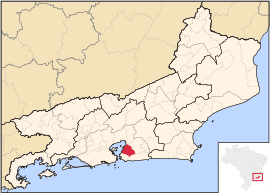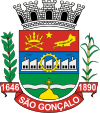São Gonçalo, Rio de Janeiro facts for kids
Quick facts for kids
São Gonçalo
|
|||
|---|---|---|---|
|
Municipality
|
|||
| Município do São Gonçalo Municipality of São Gonçalo |
|||
|
|||
| Nickname(s):
Manchester Fluminense
|
|||

Localization in Rio de Janeiro
|
|||
| Country | |||
| Region | Southeast | ||
| State | |||
| City Established | September 22, 1890 | ||
| Government | |||
| • Type | Mayor-council | ||
| • Body | Prefeitura da Cidade do Rio de Janeiro | ||
| Area | |||
| • Total | 249.142 km2 (96.194 sq mi) | ||
| Elevation | 19 m (62 ft) | ||
| Population
(2012)
|
|||
| • Total | 1,016,128 | ||
| • Density | 4,078.51/km2 (10,563.3/sq mi) | ||
| Demonym(s) | goncalense | ||
| Time zone | UTC−3 (BRT) | ||
| • Summer (DST) | UTC−2 (BRST) | ||
| Area code(s) | +55 21 | ||
São Gonçalo is a city in the state of Rio de Janeiro, Brazil. Its population (as of 2009) is 1,010,212 inhabitants, and it is the second most populous city in the state after the capital, Rio de Janeiro.
Contents
Statistics
Its population was 1,010,212 in 2009. The total area of the city is 249 square kilometres (96 square miles). It is the second most populous city in the state after Rio de Janeiro, the capital of the state.
Geography
Climate
São Gonçalo has a tropical Atlantic climate, with rainy summers and relatively dry winters. The city has different temperatures at different times of the year. They can be up to 40 °C (104 °F) in summer and 10 °C (50 °F) during winter. Generally, the temperature is between the maximum of 25 to 35 °C (77 to 95 °F) and minimum 14 to 24 °C (57 to 75 °F). But for most part of the year, i.e. from May to October, the temperature is milder because the climate is drier and less hot.
Demographics
| Year | Population |
|---|---|
| 1991 | 779,832 |
| 1996 | 831,467 |
| 2000 | 891,119 |
| 2007 | 960,631 |
| 2012 | 1,016,128 |
São Gonçalo has a high population growth rate. 1,016,128 people live in the city, up from 960,631 in 2007. According to the 2012 census, the racial makeup of São Gonçalo includes: Whites (22.7%), Brown (54.1%), Black or African (20.2%), two or more races (3%) and Asian (0.02%). The non-Brazilian population was 3.5% (Paraguayan 2%, Bolivian 1%, Chinese 0.5%), which is a high number compared to other cities in Brazil. The same census said that São Gonçalo has a large amount of poverty. 31.5% of the population was officially living in poverty in 2012, down from 81% in 1990. People considered "Class A" were only 4.7% of the population.
Education
The Rio de Janeiro State Teachers' Training College (FFP-UERJ) stands out in the city. It is the largest teachers' college in Rio de Janeiro state. Its students are mostly residents from Sao Goncalo, but many come from Niterói, Rio de Janeiro, Itaboraí, and cities of the Baixada Fluminense region, among others. For many years, students from this campus have asked for a bus route to the Saint Mary UERJ Maracanã.
Health
São Gonçalo has the following hospitals: Hospital Estadual Alberto Torres; Eye Hospital Niteroi; Hospital Luiz Palmier; Hospital Adam Pereira Nunes; Barone Hospital de Medeiros; Silveira Hospital Infantil Darcy Vargas, Hospital Pads, Hospital Santa Maria.
Garbage collection crisis
São Gonçalo has poor garbage collection services. Garbage sometimes collects on the streets for this reason. In December 2008, waste collectors went on strike, which made the problem even worse. In January 2011, garbage collection stopped for more than a week in some parts of the city.
Notable residents
Zélio Fernandino de Moraes, founder of the Umbanda Branca religious sect, was born in São Gonçalo.
Images for kids
See also
 In Spanish: São Gonçalo (Río de Janeiro) para niños
In Spanish: São Gonçalo (Río de Janeiro) para niños






